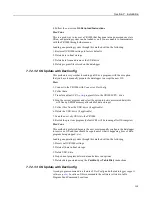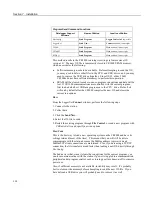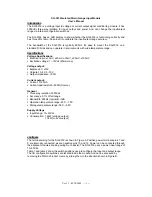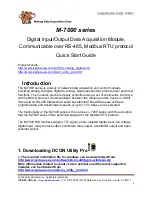
Section 7. Installation
Table 12.
Data Types in Final-Data Memory
Name
Argument
Description
Word Size
(Bytes)
Notes
Resolution / Range
UINT2
UINT2
Unsigned integer
2
Use to store positive count data ≤
+65535.
Use to store port or flag status. See
CRBasic example
Load binary
information into a variable
(p. 139).
When
Public
FLOAT
s convert to
UINT2
at final data storage, values
outside the range 0 – 65535 yield
unusable data.
INF
converts to
65535
.
NAN
converts to 0.
0 to 65535
UINT4
UINT4
Unsigned integer
4
Use to store positive count data ≤
2147483647.
Other uses include storage of long ID
numbers (such as are read from a bar
reader), serial numbers, or address.
May also be required for use in some
Modbus devices.
0 to 2147483647
Boolean
Boolean
Signed integer
4
Use to store true or false states, such
as states of flags and control ports. 0
is always false. –1 is always true.
Depending on the application, any
other number may be interpreted as
true or false. See the section
True = -
1, False = 0
(p. 164).
To save
memory, consider using
UINT2
or
BOOL8
.
True = –
1 or any number ≥ 1
False = any number ≥ 0 and < 1
Bool8
Bool8
Integer
1
8 bits (0 or 1) of information. Uses
less space than 32-bit BOOLEAN.
Holding the same information in
BOOLEAN will require 256 bits.
See
Bool8 Data Type
(p. 198).
True = 1, False = 0
NSEC
NSEC
Time stamp
8
Divided up as four bytes of seconds
since 1990 and four bytes of
nanoseconds into the second. Used to
record and process time data. See
NSEC Data Type
(p. 202).
1 nanosecond
String
String
ASCII string
Minimum: 3
(4 with null
terminator)
Default: 24
Maximum:
limited only
to the size of
available
CR1000
memory.
See caution.
1
String size is defined by the CR1000
operating system and CRBasic
program.
When converting from
STRING
to
FLOAT
, numerics at the beginning
of a string convert, but conversion
stops when a non-numeric is
encountered. If the string begins with
a non-numeric, the
FLOAT
will be
NAN
. If the string contains multiple
numeric values separated by non-
numeric characters, the
SplitStr()
instruction can be used to parse out
the numeric values. See the sections
String Operations
(p. 282)
and
Serial
I/O
(p. 245).
.
Unless declared otherwise, string size is 24
bytes or characters. String size is allocated
in multiples of four bytes; for example,
String * 25
,
String * 26
,
String * 27
, and
String * 28
allocate 28 bytes (27 usable).
Minimum string size is 4 (3 usable). See
CRBasic Editor Help
for more information.
Maximum length is limited only by
available CR1000 memory.
132
Summary of Contents for CR1000
Page 2: ......
Page 4: ......
Page 6: ......
Page 32: ......
Page 36: ......
Page 38: ......
Page 40: ......
Page 60: ...Section 4 System Quickstart Figure 16 PC200W View Line Graph 60 ...
Page 96: ......
Page 98: ...98 ...
Page 302: ......
Page 453: ...Section 8 Operation Figure 115 Using the Keyboard Display 453 ...
Page 456: ...Section 8 Operation Figure 118 Real Time Custom 456 ...
Page 457: ...Section 8 Operation 8 8 1 3 Final Memory Tables Figure 119 Final Memory Tables 457 ...
Page 458: ...Section 8 Operation 8 8 2 Run Stop Program Figure 120 Run Stop Program 458 ...
Page 460: ...Section 8 Operation Figure 122 File Edit 460 ...
Page 461: ...Section 8 Operation 8 8 4 PCCard Memory Card Display Figure 123 PCCard CF Card Display 461 ...
Page 478: ......
Page 506: ......
Page 536: ......
Page 636: ......
Page 642: ......
Page 644: ......
Page 676: ......
Page 677: ......
















































